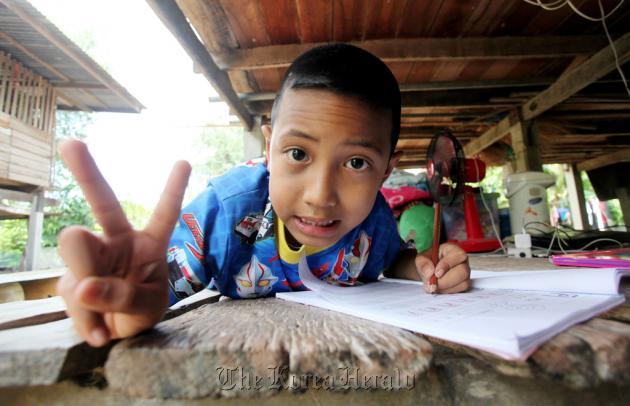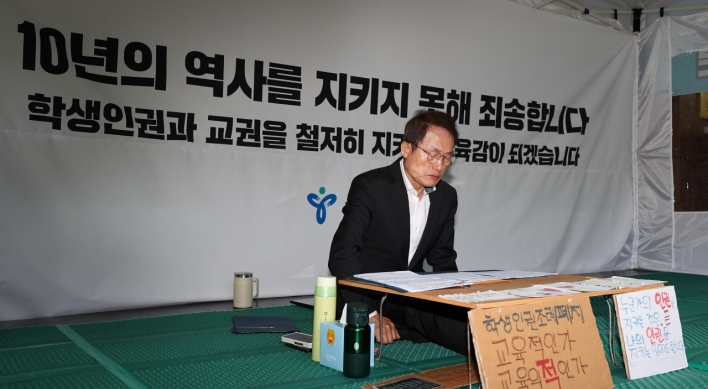Petcharat Pokrang says it is a miracle that her 7-year-old son Palwawat, or “Ton Kla,” survived after being diagnosed with severe aplastic anaemia ― a condition in which bone marrow fails to produce sufficient new blood cells ― in April last year.
Doctors in Saraburi told her the boy would not survive without a bone-marrow transplant, which costs up to 1 million baht ($32,400).
Petcharat could not afford it. But as the boy’s condition worsened ― the whites of his eyes turned red and he experienced oral bleeding ― his local doctor helped him to obtain assistance from the Ramathibodi Hospital Foundation to seek free treatment. Ton Kla received a stem-cell transplant using tissue taken from his younger brother Noppaklao in August. He was released from hospital one month later and now lives a normal life, playing with his friends.
Initially, Petcharat believed it was her son’s karma to suffer from such a deadly disease. She blamed herself, because she had tried to have an abortion when she was bearing her youngest son. However, the doctors told her the disease could have been caused by any one of a number of factors, such as living close to factories releasing toxic chemicals, heredity, or insecticides from fruits and vegetables.
Doctors in Saraburi told her the boy would not survive without a bone-marrow transplant, which costs up to 1 million baht ($32,400).
Petcharat could not afford it. But as the boy’s condition worsened ― the whites of his eyes turned red and he experienced oral bleeding ― his local doctor helped him to obtain assistance from the Ramathibodi Hospital Foundation to seek free treatment. Ton Kla received a stem-cell transplant using tissue taken from his younger brother Noppaklao in August. He was released from hospital one month later and now lives a normal life, playing with his friends.
Initially, Petcharat believed it was her son’s karma to suffer from such a deadly disease. She blamed herself, because she had tried to have an abortion when she was bearing her youngest son. However, the doctors told her the disease could have been caused by any one of a number of factors, such as living close to factories releasing toxic chemicals, heredity, or insecticides from fruits and vegetables.

Ton Kla’s is just one of many lives that the Ramathibodi Hospital Foundation has saved. Among the many other survivors is 4-year-old Anat Thongta, who was diagnosed with thalassemia when he was 2. He will undergo a bone-marrow transplant, thanks to the foundation’s help. Saengduan Thongta, Anat’s mother, said getting support from the foundation meant the world to her family, which has been paying 5,000 baht a month for blood transfusions to keep the child alive.
Maneerat Pimnont, 32, who suffers from systemic lupus erythematosus and chronic renal failure, received a free kidney transplant in April last year. She is profoundly grateful to the foundation, saying she has embraced her new life and gone are the days when she suffered torment and misery.
Dr. Suradet Hong-ing, vice president in charge of stem-cell transplants at Ramathibodi Hospital, said stem-cell technology had enabled the hospital to treat patients suffering from liver and kidney disease, leukemia, lymphoma, thalassemia, aplastic anemia and immuno-deficiency.
The hospital is seeking approval from the National Health Security Office to allow patients suffering from these diseases to receive free treatment under NHSO sponsorship. Less than 10 percent of the Thai population can afford a 1 million baht organ or stem-cell transplant, Suradet said.
“There are more than 4,000 people who are suffering from thalassemia and waiting to get stem-cell transplants; every day some die before they can reach hospital,’’ he said. The hospital was the first in Thailand to carry out a liver transplant from a parent to a child, and the first in Asia to successfully perform kidney and bone-marrow transplants, which free patients from the need to take immune system suppressants.
”We are the first hospital in the country to perform a stem-cell transplant from a person who was not a blood relative of the patient,’’ Suradet said.
Currently, the odds of finding a stem-cell donor whose tissue matches a patient are 1 in 30,000, because Thailand started to seek stem-cell donations just 10 years ago, and has only 140,000 registered donors.
The hospital has performed more than 600 bone-marrow transplants since 1989. Due to limited state funding, medical facilities and personnel, the hospital can only perform stem-cell and organ transplants for 10 people per month.
The professor has called on the government to increase funding for research in stem-cell technology, as he believes the hospital has the potential to become the region’s leader in this field.
“Research in this medical technology can definitely improve Thais’ health and well-being, which in turn will help save the state money needed to provide medical treatment for patients,” Suradet said.
By Thanapat Kitjakosol
(The Nation)
-
Articles by Korea Herald




![[KH Explains] No more 'Michael' at Kakao Games](http://res.heraldm.com/phpwas/restmb_idxmake.php?idx=644&simg=/content/image/2024/04/28/20240428050183_0.jpg&u=20240428180321)













![[Herald Interview] Mistakes turn into blessings in street performance, director says](http://res.heraldm.com/phpwas/restmb_idxmake.php?idx=652&simg=/content/image/2024/04/28/20240428050150_0.jpg&u=20240428174656)
